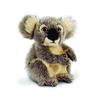Product Introduction
As a Decorative Item or Collectible
HANSA dolls are beloved by children and adults alike for their realistic expressions, adorableness, and decorative appeal. We're also gradually expanding our collection of practical, realistic plush stools, cushions, rugs, and other items that are easy to incorporate into your home decor.
Welcome these animal friends into your home, decor, or even your relaxing office space.
Safety Warning
Keep away from open flames as they may cause deformation, deterioration, or fire. Small parts are used inside and on the surface. Do not give to children under 6 years of age to prevent accidental ingestion. Please be aware of the possibility of discoloration or color transfer due to friction.
Product Type: Realistic Animal Hand Puppet
Animal: Koala
About HANSA: Founded in Australia in 1972, HANSA has researched a variety of creatures, primarily those living on Earth, and has crafted meticulously realistic plush toys. To ensure that all HANSA products meet our required quality standards, we manufacture them in our own 12,000-square-meter factory in the Philippines, without the use of subcontractors. We work with museums, environmental protection organizations, and educational institutions to spread awareness of the world's animals and the importance of protecting the environment.
What kind of stuffed animals are HANSA? HANSA's stuffed animals are produced using advanced technology to recreate animals that live all over the world, from familiar pets and well-known animals kept in zoos to local endemic species, ancient dinosaurs and extinct species, and fantasy creatures. They range from palm-sized animals to life-size stuffed animals like a 4.8m giraffe. We have contracts with international testing agencies and issue inspection certificates for each product.
Why realistic stuffed animals? HANSA's reason for continuing to make realistic stuffed animals stems from our philosophy of environmental conservation, which is to help the next generation of children understand not only the appearance and ecology of animals found all over the world, but also the fact that the impact of humans, such as deforestation and environmental pollution, is taking away their habitats.




















